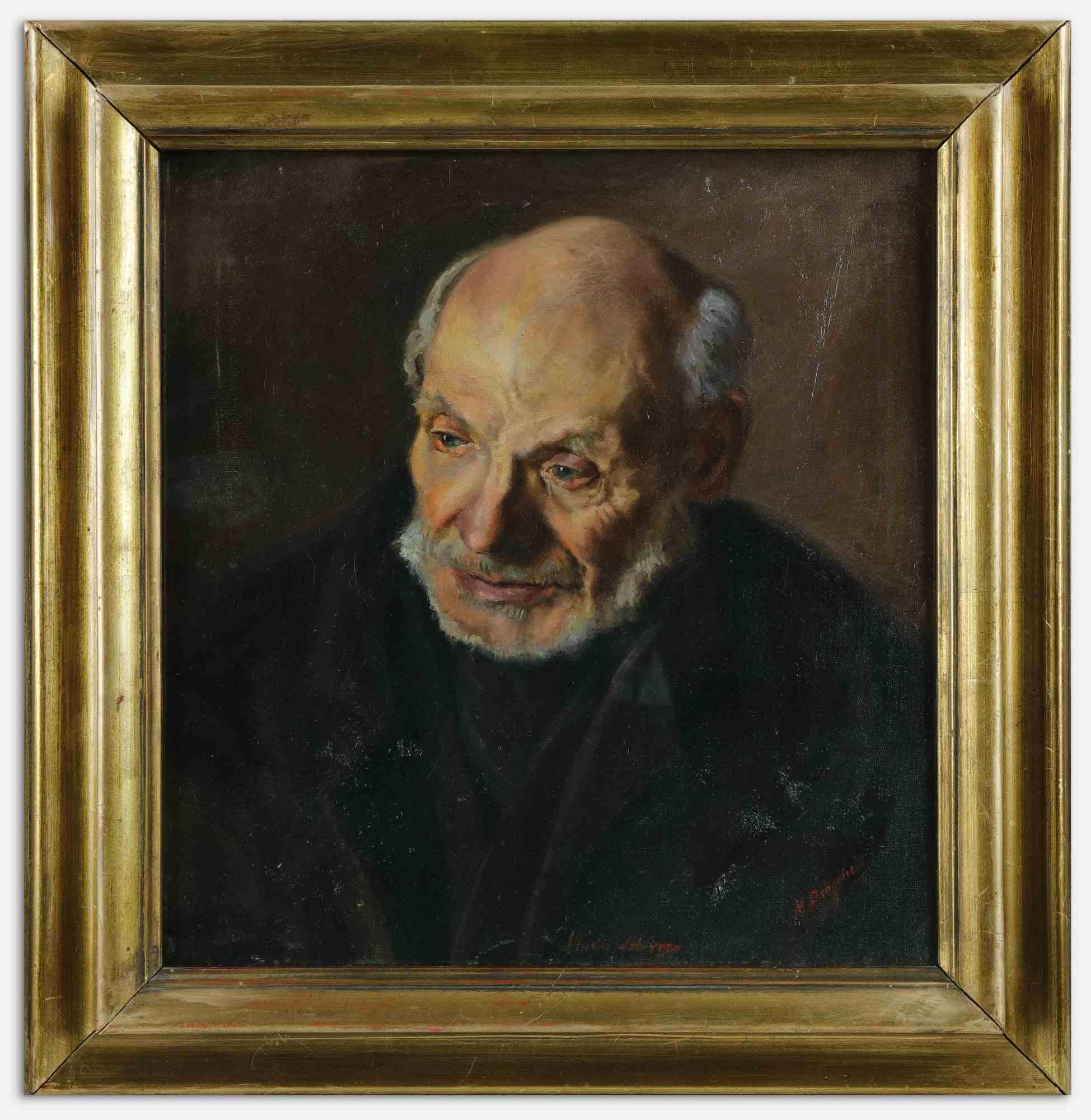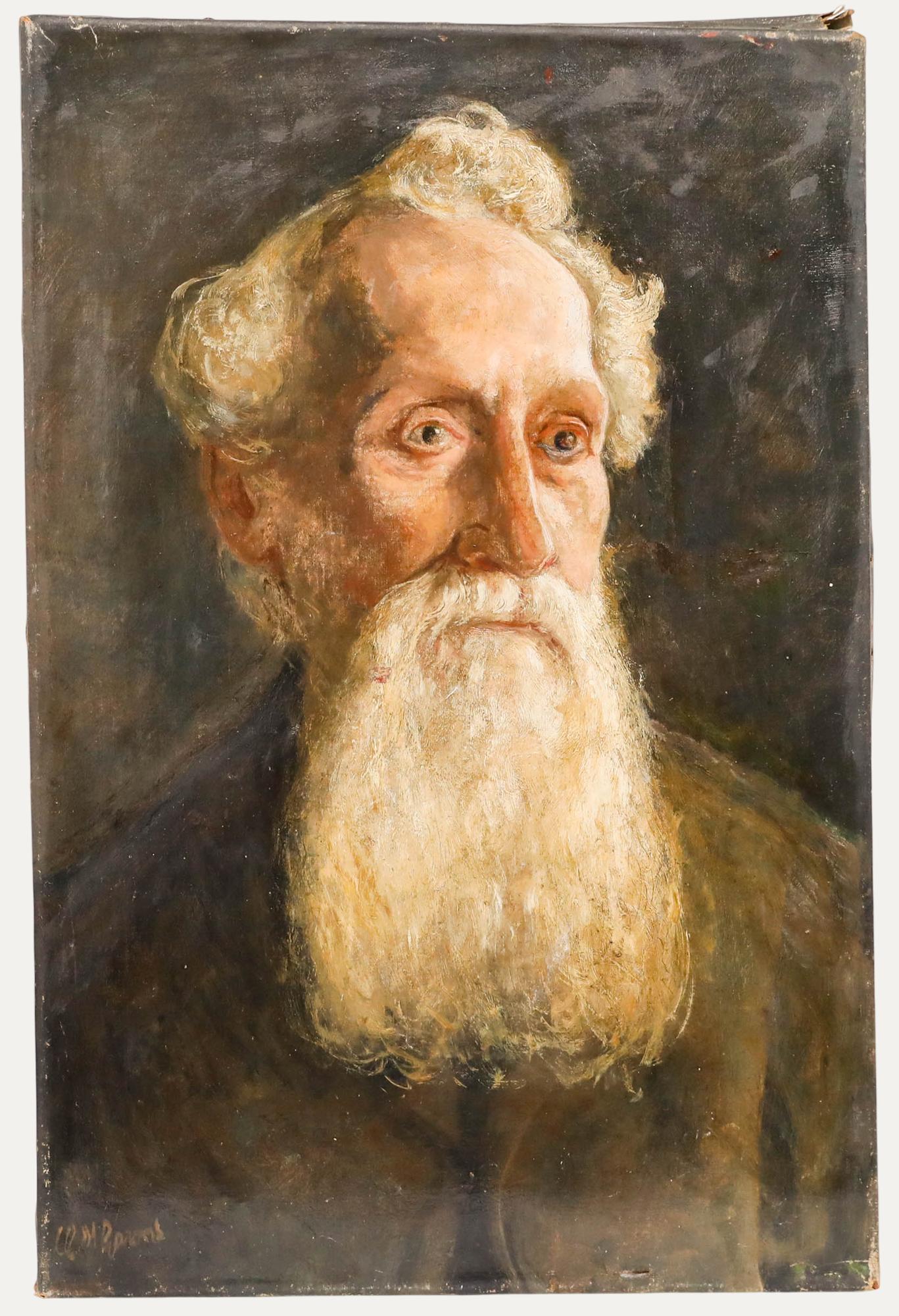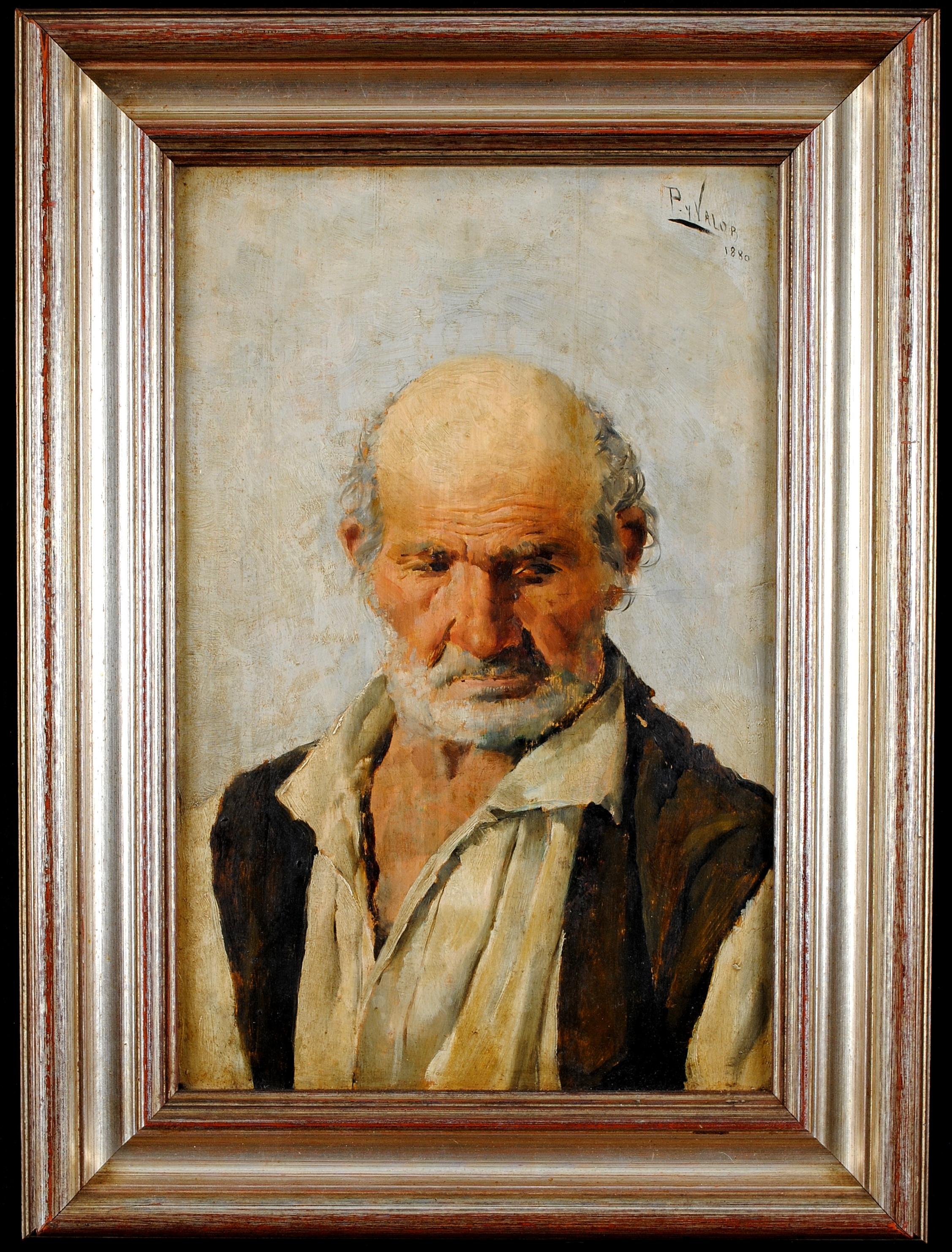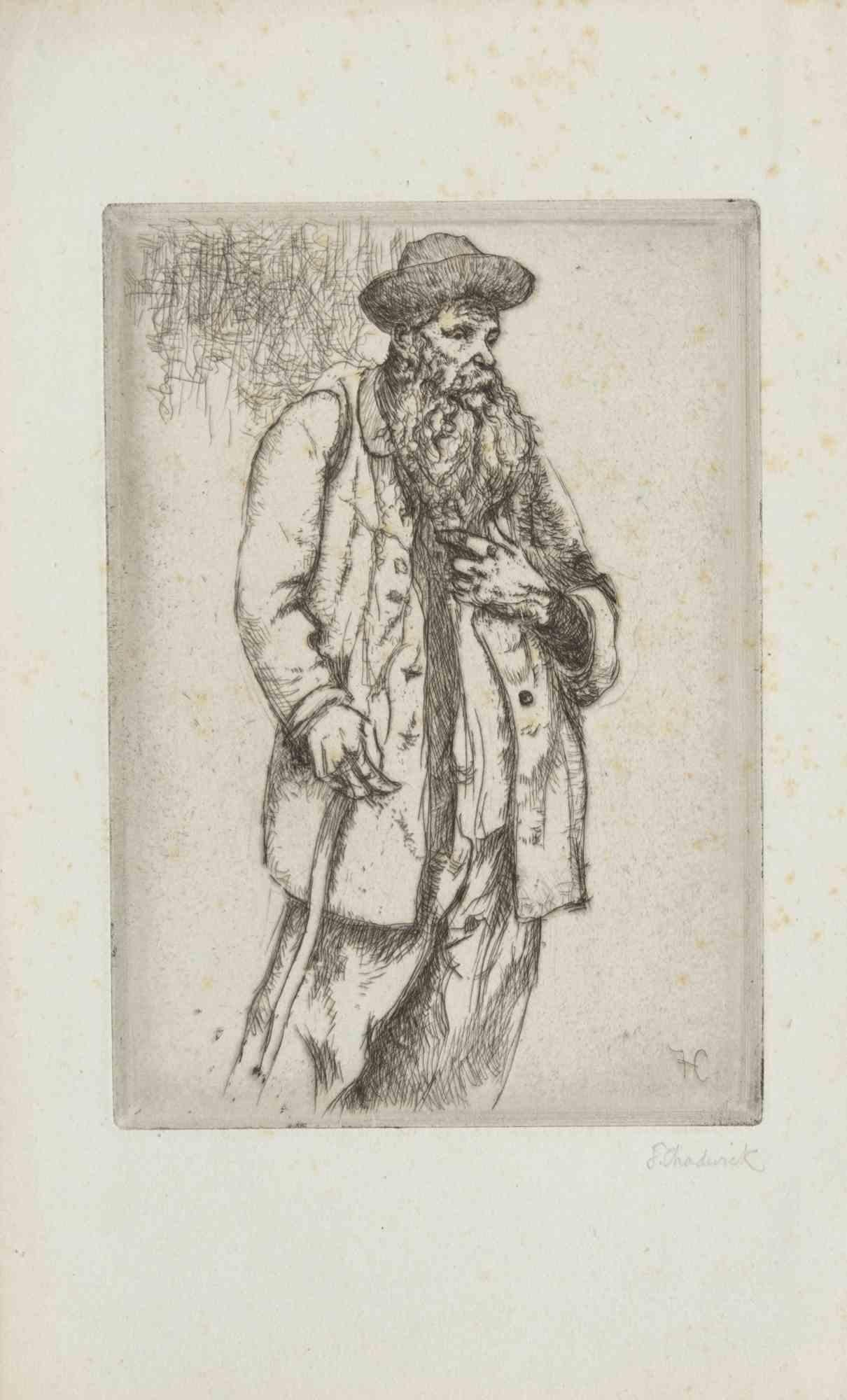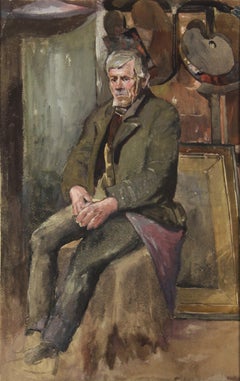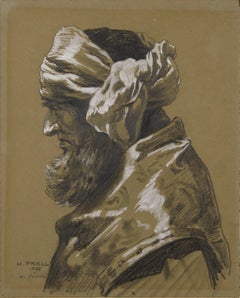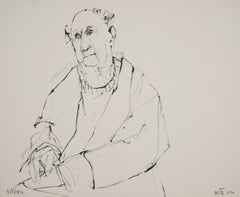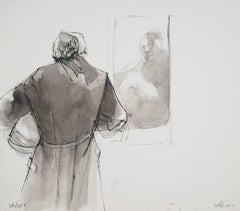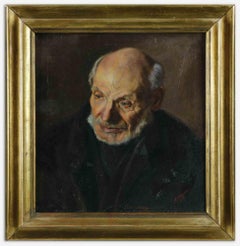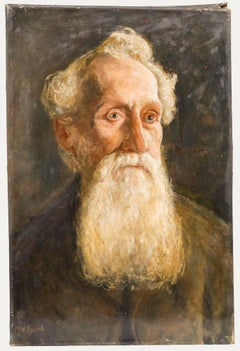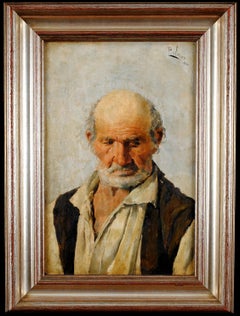Items Similar to Half-length portrait of an elderly bearded man - Melancholy of a prophet -
Want more images or videos?
Request additional images or videos from the seller
1 of 8
Friedrich August SeitzHalf-length portrait of an elderly bearded man - Melancholy of a prophet -1926
1926
$1,700.70
$2,125.8820% Off
£1,274.36
£1,592.9520% Off
€1,440
€1,80020% Off
CA$2,387.98
CA$2,984.9720% Off
A$2,617.15
A$3,271.4420% Off
CHF 1,366.73
CHF 1,708.4120% Off
MX$31,402.78
MX$39,253.4720% Off
NOK 17,161.57
NOK 21,451.9620% Off
SEK 16,165.56
SEK 20,206.9520% Off
DKK 10,968.18
DKK 13,710.2320% Off
About the Item
Friedrich August Seitz (1902 Staffort - 1944 Belgrade). Half-length portrait of an elderly man with a beard. Oil on canvas, 42 x 34 cm (visible seize), 58 x 50 cm (frame), signed and dated lower left "Aug. Seitz. 1926". In an Art Nouveau frame with gilt stucco and black lacquered moulding.
- Melancholy of a prophet -
About the artwork
The head shown is not the portrait of a real person, but aims at a much more general dimension of meaning that transcends the individual person. Such expressive heads were called 'tronies' in the Netherlands from the 16th century onwards and flourished in the 17th century. But they go back much further, to the sculptural rows of apostles and prophets in Gothic cathedrals. And it is precisely to these that Friedrich August Seitz refers. The head, which is shown in a slight top view and appears almost gaunt, looks like a prophet's head with its flowing white beard. This is reinforced by the deeply shadowed eye area, which refers to the topos of the 'blind seer'.
The head is given a particular liveliness by the light colours and the loose application of paint, which at first glance seem to counteract the darkness of the prophecy, and by which the picture follows in the footsteps of the art of Frans Hals and Max Liebermann. The head seems to materialise directly from the paint, which has been applied with the greatest virtuosity, while the brushwork around the head and the apparently untreated ground enliven the figuratively undefined surface. The concretion of the head, however, culminates in the shadowed eye area, which repeatedly draws the eye to itself and thus to the invisible. In this way, Friedrich August Seitz manages to revive the ancient theme of the prophets in a highly expressive way, using the same painterly means as Frans Hals and Max Liebermann used for their predominantly profane subjects.
About the artist
Friedrich August Seitz studied at the Karlsruhe Art Academy under Prof. August Babberger from 1923 to 1927. After his studies he worked as a fashion draughtsman for Schöpflin in Hagen and then as a technical draughtsman for the Badische Landesvermessung in Karlsruhe. He was drafted into the Wehrmacht in 1939 and died on a train to Belgrade in 1944.
GERMAN VERSION
Friedrich August Seitz (1902 Staffort - 1944 Belgrad). Brustbild eines älteren bärtigen Mannes. Öl auf Leinwand, 42 x 34 cm (Innemaß), 58 x 50 cm (Rahmen), links unten signiert und datiert „Aug. Seitz. 1926“. Im Jugendstil-Rahmen mit Goldstuck und schwarz gelackter Leiste.
- Die Melancholie eines Propheten -
zum Werk
Der dargestellte Kopf ist nicht das Porträt einer realen Person, sondern zielt auf eine die individuelle Person übersteigende, weit allgemeinere Bedeutungsdimension. Solche Ausdrucksköpfe wurden seit dem 16. Jahrhundert in den Niederlanden als „Tronies“ bezeichnet und erlebten insbesondere im 17. Jahrhundert eine Blütezeit. Sie reichen jedoch viel weiter bis zu den skulpturalen Apostel- und Prophetenreihen der gotischen Kathedralen zurück. Und eben diesen Bezug stellt Friedrich August Seitz her. Der in leichter Aufsicht gezeigte, beinahe hager wirkende Kopf mutet mit seinem wallenden weißen Bart wie ein Prophetenkopf an. Dies wird noch zusätzlich durch die tief verschattete Augenpartie verstärkt, die sich auf den Topos des ‚blinden Sehers‘ bezieht.
Eine besondere Lebendigkeit gewinnt der Kopf vermittels der die Dunkelheit der Prophetie auf den ersten Blick geradewegs konterkarierenden hellen Farbigkeit und dem lockeren Farbauftrag, durch welche das Bild in die Nachfolge der Kunst eines Frans Hals und Max Liebermann tritt. Durch den mit größter Virtuosität erfolgten Farbauftrag scheint sich der Kopf geradewegs aus der Farbe heraus zu materialisieren, während um den Kopf herum der Pinselduktus und der unbehandelt anmutende Malgrund die gegenständlich nicht näher bestimmte Bildfläche beleben. Die Konkretion des Kopfes kulminiert aber nun gerade in der den Blick immer wieder auf sich ziehenden verschatteten Augenpartie und damit in dem, was nicht sichtbar ist. Auf diese Weise gelingt es Friedrich August Seitz durch malerische Mittel, wie sie bei Frans Hals und Max Liebermann in ihren vorwiegend profanen Sujets vor Augen stehen, das alte Thema der Prophetendarstellungen auf eine äußerst expressive Weise zu revitalisieren.
zum Künstler
Friedrich August Seitz besuchte unter Prof. August Babberger von 1923 bis 1927 die Kunstakademie Karlsruhe. Nach dem Studium war er zunächst als Modezeichner bei Schöpflin in Hagen tätig und dann als technischer Zeichner bei der Badischen Landesvermessung in Karlsruhe angestellt. 1939 zur Wehrmacht einberufen, verstarb er 1944 auf einer Zugfahrt nach Belgrad.
- Creator:Friedrich August Seitz (1902 - 1944, German)
- Creation Year:1926
- Dimensions:Height: 16.54 in (42 cm)Width: 13.39 in (34 cm)Depth: 1.97 in (5 cm)
- Medium:
- Movement & Style:
- Period:
- Condition:
- Gallery Location:Berlin, DE
- Reference Number:1stDibs: LU2438212325652
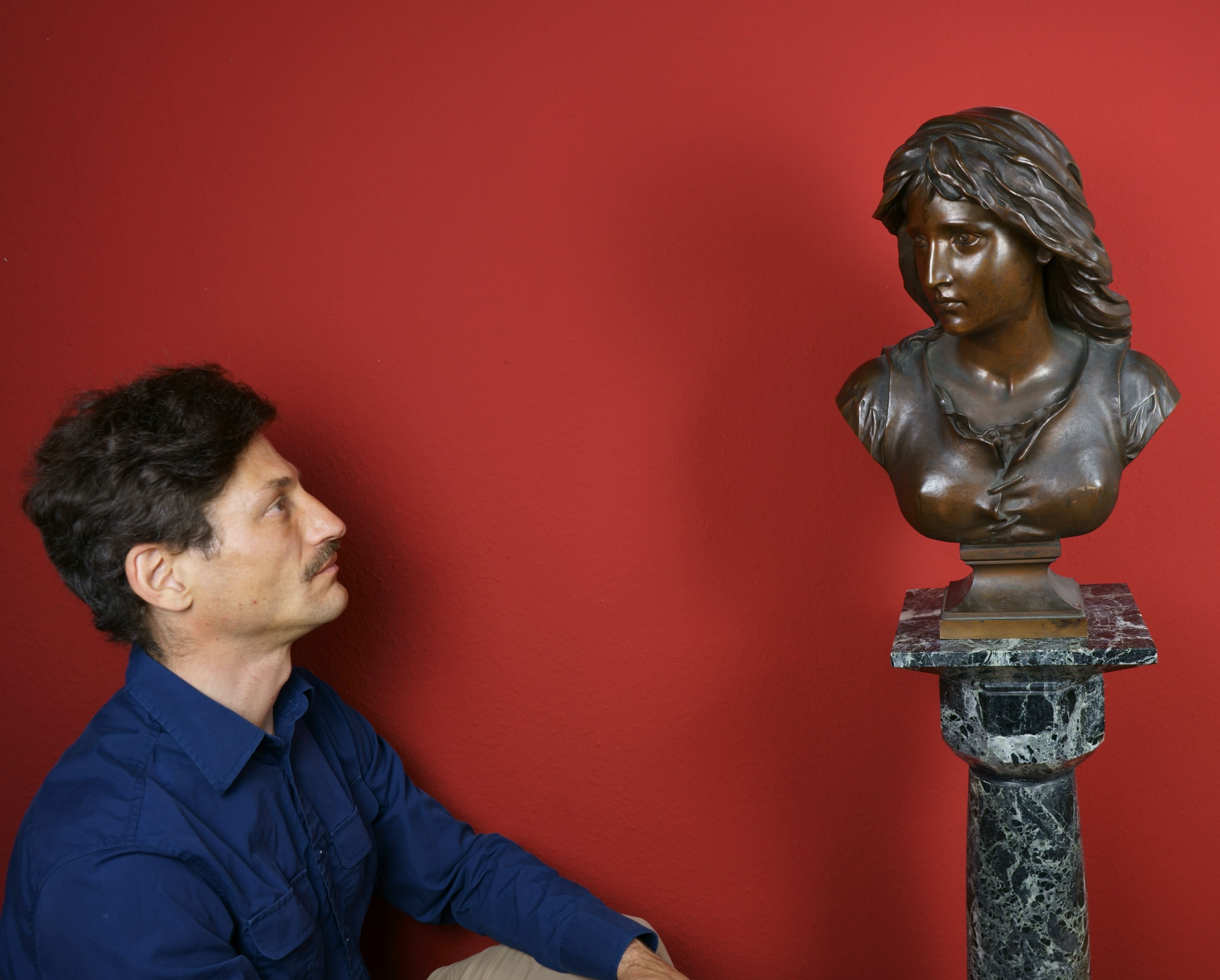
About the Seller
5.0
Vetted Professional Seller
Every seller passes strict standards for authenticity and reliability
Established in 2014
1stDibs seller since 2023
21 sales on 1stDibs
- ShippingRetrieving quote...Shipping from: Berlin, Germany
- Return Policy
Authenticity Guarantee
In the unlikely event there’s an issue with an item’s authenticity, contact us within 1 year for a full refund. DetailsMoney-Back Guarantee
If your item is not as described, is damaged in transit, or does not arrive, contact us within 7 days for a full refund. Details24-Hour Cancellation
You have a 24-hour grace period in which to reconsider your purchase, with no questions asked.Vetted Professional Sellers
Our world-class sellers must adhere to strict standards for service and quality, maintaining the integrity of our listings.Price-Match Guarantee
If you find that a seller listed the same item for a lower price elsewhere, we’ll match it.Trusted Global Delivery
Our best-in-class carrier network provides specialized shipping options worldwide, including custom delivery.More From This Seller
View AllMan sitting in the studio - Thinking about art -
Located in Berlin, DE
Adolph Eduard Otto von Faber du Faur (1828 Ludwigsburg - 1901 Munich). Man sitting in the studio. Watercolour painting, 43 x 27 cm (visible size), 73 x 53 cm (frame), monogrammed at lower right, estate stamp.
Upper right corner neatly repaired, small tear in the wall to the left of the sitter.
- Thinking about art -
About the artwork
The sitter, an elderly man, is seated in a studio on a pedestal reminiscent of an academy hall. The earthy, dark tones give the scene a weighty quality. The lightest tones are found in the incarnate parts of the figure, which do not stand out from the other colours of the picture, but are linked to them. As a result, the sitter's face is both part of and the highlight of the colour references in the picture. The colour of the sitter's skin is reflected in his pink coat, while his white-grey hair matches the colour of the wall next to him. This almost monochrome wall surface, in turn, is connected across the portrait to the framed picture standing on the floor, which seems to have been erased by this correspondence with the empty wall surface. Through the palette, which is positioned directly behind the sitter's head, the reference to painting, which is already given by the studio space, is explicitly linked to the sitter, who thus seems to be contemplating the question of the meaning of art.
This raises the question of whether Faber Du Faur, who had become lonely in his old age, might have painted a self-portrait here in his later years. In addition to the studio setting, the sitter's explicit reference to the palette and the fact that the picture was part of his estate, the only summary elaboration of the body suggests a self-portrait, while the representation of the face is concretised with the wide-open eyes typical of a self-portrait. This concentration on the face gives the impression of the artist's melancholy introspection, captured by the palette and related to the meaning of painting, whose dark character is reinforced by the concealment of the palette hanging on the right of the picture in the light tones so characteristic of Faber Du Faur. In the course of this resignation, Faber du Faur advises his son Hans, who has also become a painter: "Promise me one thing: never move to Munich, they'll kill you here!"
Whoever the sitter may be, the references to painting make the portrait a resigned self-contemplation by Faber Du Faur, focused on art.
About the artist
After leaving school, Otto Faber du Faur entered the service of the Württemberg army, at the same time cultivating his artistic talent. In 1851, on the recommendation of his father Christian Wilhelm, who was himself a battle painter, he spent six months in Munich as an apprentice to Alexander von Kotzebue. In 1852 he was granted a year's leave of absence from military service to study battle painting in the studio of Adolphe Yvon...
Category
1890s Realist Portrait Drawings and Watercolors
Materials
Watercolor
$897 Sale Price
20% Off
Half-length portrait of a Pharisee - In the shadow of betrayal -
Located in Berlin, DE
Hermann Prell (1854 Leipzig - 1922 Dresden-Loschwitz). Half-length portrait of a Pharisee, 1885. Sketch for the right-hand figure in the painting Judas Iscariot, 1886. Pencil drawing heightened with opaque white and black chalk on beige-grey wove paper (papier vélin), 34 x 27.8 cm (visible size), 52 x 45 cm (mount), signed, dated and inscribed "H. PRELL 1885 zu 'Judas'".
Minor browning, collection stamp on the reverse.
- In the shadow of betrayal -
About the artwork
This painting is the sketch for the head of the Pharisee offering the coins to Judas in one of Herrmann Prell's major works, the painting Betrayal of Judas, completed in 1886. The painting belongs to the Staatliche Kunstsammlungen Dresden and is illustrated in Adolf Rosenberg: Prell, Bielefeld and Leipzig 1901, p. 21 (Fig. 19). It is especially highlighted in Thieme-Becker (vol. 27, p. 376).
Hermann Prell, Betrayal of Judas, 1886
The monumental head, which fills the picture and is distinguished by its ornamented robe, is almost a lost profile, which in the executed painting is justified by the Pharisee's turning towards Judas. Despite the fact that the sitter withdraws from the viewer by turning away, it was necessary to artistically elaborate the motivation for the purchase of one of Christ's disciples, which is why the drawing focuses on the expression of the face, while the 'accessories' are treated in a more summary manner.
In characterising the face, Hermann Prell performs a balancing act: since the Pharisee, despite his destructive actions, is an actor in the history of salvation, the head must show a dignity appropriate to the event, but at the same time the physiognomy must also bear witness to the scheming attitude that led to the betrayal. To solve this dilemma, Prell draws on the traditional depictions of the heads of the apostles, shading the face to indicate the obdurate darkness of the spirit and moving the base of the nose slightly upwards while the mouth falls away, thus giving a physiognomic expression to the motivation of the action. The fatal drama of the betrayal is expressed in the monumentalisation of the head and in the thunderous white highlights that contrast with the darkness of the chalk.
As a study, considered by the artist to be a work in itself, this drawing reveals the pictorial problems and brainstorming of monumental painting.
About the artist
In 1872 Prell, who was one of the most important exponents of monumental painting of his time, began studying painting with Theodor Grosse at the Dresden Academy of Art and continued with Carl Gussow at the Berlin Academy in 1876. Hans von Marées taught him in Rome in 1878. More influential on his work, however, were Arnold Böcklin and Max Klinger, with whom Prell had been friends since his student days and with whom he worked together on several occasions.
Prell's first major work, which established his reputation as a monumental painter, were the frescoes in the banqueting hall of the Architektenhaus in Berlin in 1881/82, commissioned by the state and depicting the different periods of architecture. Prell then went to Italy for two years to study fresco painting. Other major commissions followed. These included monumental frescoes in the town halls of Worms (1884), Hildesheim (1882-92), Gdansk (1895) and Dresden, the staircase of the Silesian Museum of Fine Arts in Breslau (1893/94), the throne room of the German Embassy in Rome (1896-99) and the staircase of the Albertinum in Dresden (1900-1904).
From 1886 Prell taught at the academy of arts in Berlin and in 1892 he was appointed professor at the academy of arts in Dresden. His students included Osmar Schindler and Hans Unger...
Category
1880s Realist Figurative Drawings and Watercolors
Materials
Chalk
$1,417 Sale Price
20% Off
Contemplating old man / - The View into Life -
By Ruth Schloss
Located in Berlin, DE
Ruth Schloss (1922 Nuremberg - 2013 Kfar Shmaryahu), Contemplating old man, around 1990. Mixed media on watercolor paper, 33 cm x 40 cm, signed “Schloss” lower left and again in Hebr...
Category
1990s Realist Figurative Drawings and Watercolors
Materials
Paper
Old man in front of a mirror / - Diffusion -
By Ruth Schloss
Located in Berlin, DE
Ruth Schloss (1922 Nuremberg - 2013 Kfar Shmaryahu), Old man in front of a mirror, around 1990. Mixed media on watercolor paper, 33.5 cm x 40 cm, signed “Schloss” lower left and agai...
Category
1990s Realist Figurative Drawings and Watercolors
Materials
Paper
Half-length portrait of a man with beard - A Rembrandt of the 18th century -
Located in Berlin, DE
Johann Friedrich Bause (1738 Halle a. d. Saale - 1814 Weimar). Half-length portrait of a man with beard and cap after a drawing by Christian Wilhelm Ernst Dietrich. Etching and coppe...
Category
1780s Baroque Figurative Prints
Materials
Etching
Rudolf v. Rittner as Florian Geyer - Last man standing -
By Lovis Corinth
Located in Berlin, DE
Lovis Corinth (1858 Tapiau - 1925 Zandvoort), Rudolf von Rittner as Florian Geyer, 1924 (Müller 854), drypoint signed in pencil. 20.4 × 14.2 (plate size), 37.7 × 30.6 cm (sheet size). Published by Karl Nierendorf, Berlin. Framed in a passepartout.
- Strong, precise impression. Frame a little bit rubbed and with two small damages.
About the artwork
The knight is a leitmotif in Lovis Corinth's work, culminating in his Self-Portrait in Armour of 1914. Of all the paintings on this theme, Corinth most often depicted Florian Geyer. Descended from a Franconian noble family, he fought for the freedom of the peasants during the peasant wars of the Reformation, first diplomatically and then militarily, leading the legendary Schwarzen Haufen (Black Troops). The name derives from the black uniforms with which Geyer dressed the peasants willing to fight.
During the Napoleonic occupation, the freedom fighter Florian Geyer was sung about by the Romantics, and the free corps Die Schwarze Schaar, founded in 1813 by Major von Lützow, succeeded the Schwarzer Haufen. It was against this historical background that Gerhard Hauptmann wrote the revolutionary drama Florian Geyer, which premiered at the Deutsches Theater in Berlin in 1896. While the actor Rudolf Rittner, who would later appear in Fritz Lang's films, initially played the role of Schäferhans, he took over the leading role in the new production at Berlin's Lessing Theatre in 1904, again directed by Emil Lessing, which established his fame as an actor. Hauptmann himself praised the acting. He wrote to Hugo von Hofmannsthal: "It went quite well with Florian Geyer. In any case, I had the great pleasure of seeing the play again in an admirable performance". And Lovis Corinth was so taken with Rittner's performance that he painted an oil portrait of him in the role of Florian Geyer in 1906.
After two further graphic versions in 1915 and 1920/21, Corinth returned to the painting a year before his death and almost twenty years after the oil painting to create this graphic version in 1924. Even the inscription in the picture was taken over. This proves all the more the importance of the knight and freedom fighter for Corinth's self-image.
The oil painting, in particular, proclaims the single-minded determination to fight to the last for the values defended, manifested in the oil painting by the tattered flag held out to the enemy. There is a parallel with Rainer Maria Rilke's 1899 story The Cornet, in which the protagonist goes down with the flag that he first saved at the risk of his life.
Consequently, the portrait is also a self-portrait, and the knight's armour is not an academic costume or an ironic refraction, but an expression of Corinth's self-image, which also includes his self-representation as an artist. The Secession poster...
Category
1920s Expressionist Figurative Prints
Materials
Etching
$897 Sale Price
20% Off
You May Also Like
Study of Man - Oil Paint attributed by Marcello Dragonetti - Late 19th Century
Located in Roma, IT
Study of man is an original artwork realized in the late 19th Century and attributed to the painter Marcello Dragonetti.
Mixed colored oil paintig on canvas.
Titled and signature ...
Category
19th Century Modern Portrait Paintings
Materials
Oil
Coenraad Matthias Garms (1863-1944) - Dutch Oil, Portrait of a Bearded Man
Located in Corsham, GB
This intimate oil portrait captures an elderly gentleman with distinctive white hair and a full beard. Painted in a realistic style, the work emphasises the character and wisdom of t...
Category
Late 19th Century Portrait Paintings
Materials
Oil
Old man elderly oil on board painting
Located in Sitges, Barcelona
Anonymous - Old man - Oil on board
Oil size 34x25 cm.
Frameless
Category
1920s Baroque Portrait Paintings
Materials
Canvas, Oil
Portrait of a Man - 19th Century Spanish Antique Oil on Panel Painting
Located in Sevenoaks, GB
A fine signed and dated 1880 Spanish oil on panel portrait of a man wearing a white shirt and waistcoat by Manuel Pla y Valor. The work is superbly ...
Category
1880s Realist Portrait Paintings
Materials
Oil, Panel
Paul Schouten (1860-1922) Portrait painting of elderly gentleman with beard
By Paul Schouten
Located in San Francisco, CA
Paul Schouten (1860-1922) Portrait painting of elderly gentleman with beard
Oil on board
9 x 12 unframed
Category
Early 20th Century Portrait Paintings
Materials
Oil, Board
Portrait of Old Man - Etching by Francis Brooks Chadwick - 1915
By Francis Brooks Chadwick
Located in Roma, IT
Etching and drypoint realized by Chadwick in 1915.
Hand signed in pencil lower right.
Very good condition.
Category
1910s Modern Figurative Prints
Materials
Etching
More Ways To Browse
16th Century Portrait Oil Paintings
Antique Nun
Man With Beard
Frans Hals
Bearded Painting
Bearded Man Painting
1944 Portraits
Concrete Head
Oil Painting Lovers
Paintings Of Chairs
Portrait Pope
Saturday Evening Post Illustration
Antique Nurses
Hyperrealism Paintings
Painting Antique Windows
Tavern Painting
Tavern Paintings
Moises Vintage
